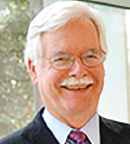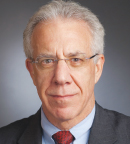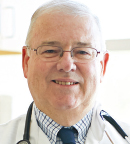One of the featured “Big Debates” at the 2016 World Cancer Congress in Paris addressed this question: Are scarce resources best applied to prevention rather than treatment?

Richard Larson, MD
Many experts do not see prevention vs treatment in such stark terms or even as a realistic scenario. It’s a false dichotomy, said the University of Chicago’s Richard Larson, MD, speaking a few months later at the National Cancer Policy Forum (NCPF, part of the National Academy of Medicine) workshop on Cancer Care in Low-Resource Settings in Washington, DC. “Both are important and both are interdependent.”
But the debate topic highlighted the hard choices providers and policy makers in many low-resource areas must face. “We do have to think through how to adapt to existing resources in a meaningful way; we have to think out of the box,” said another speaker at the National Cancer Policy Forum, Benjamin O. Anderson, MD, Professor of Surgery and Global Health at the University of Washington, Seattle.

This concept of resource stratification is not certifying substandard care. It’s about how you build the system. Without prioritization, you won’t have a system functioning well.— Benjamin O. Anderson, MD
Tweet this quote
The National Cancer Policy Forum’s workshop was the second to look at cancer care in low-resource areas. The first, in 2015, focused on prevention and early detection, whereas the 2016 workshop considered treatment, including palliative and survivorship care. The purpose was to “consider low-resource areas both domestically and internationally and understand whether there are lessons that may be transferable,” said Dr. Larson, who co-chaired the workshop’s planning committee with Robert Carlson, MD, Chief Executive Officer of the National Comprehensive Cancer Network® (NCCN®).
A large proportion of all cancers and cancer deaths occur in low-resource areas, according to various measures. For instance, the Lancet Oncology Commission on Global Cancer Surgery found that over 80% of 15 million people diagnosed with cancer worldwide in 2015 would need a surgical procedure at some point in their treatment.1 However, three-quarters of those procedures were undelivered, unsafe, and/or unaffordable.
“The question becomes, how do we fix this, how do we address these issues,” said Dr. Anderson.
Defining Priorities
One answer, he and other speakers said, is through a system that identifies priorities at different resource levels.2 For example, the Breast Health Global Initiative, a partnership between the Fred Hutchinson Cancer Research Center and Susan G. Komen for the Cure, has developed guidelines for breast cancer adapted to four different resource levels.2 At the “basic” level, its guidelines identify treatments considered essential at any level. For premenopausal women diagnosed with locally advanced breast cancer, for instance, those treatments are a modified radical mastectomy, chemotherapy for estrogen receptor–negative cancers, and oophorectomy, and/or tamoxifen for estrogen receptor–positive cancers.

Robert Carlson, MD
Areas with “limited” resources might add postmastectomy irradiation for locally advanced cancers, a treatment intended to improve outcome without major expense in settings where radiation treatment is available and accessable.
Areas with “enhanced” resources may consider breast-conserving surgery and more expensive drugs, such as trastuzumab (Herceptin), to improve outcomes further and increase patient options.
“Maximal” resources allow for measures that may be helpful but are low priority due to extreme cost or impracticality. In the case of premenopausal women with locally advanced disease, these measures include the use of growth factors and dose-dense chemotherapy, according to the Breast Health Global Initiative guidelines.
“I do want to say that this concept of resource stratification is not certifying substandard care,” revealed Dr. Anderson, who leads the Breast Health Global Initiative. “It’s about how you build the system—the foundation, then the first floor, then the second floor. You first have to be able to provide a mastectomy without leaving tumor behind. Without prioritization, you won’t have a system functioning well.”
ASCO and NCCN Guidelines
ASCO has used four similar resource levels to create detailed recommendations for cervical cancer, tailored to providers working with various scenarios. For example, in basic settings, “where patients cannot be treated with radiation therapy, extrafascial hysterectomy either alone or after neoadjuvant chemotherapy” is recommended. And in limited settings, “while concurrent radiotherapy and chemotherapy is standard in enhanced and maximal settings for women with stages IB to IVA disease, the panel stresses the addition of low-dose chemotherapy during radiotherapy, but not at the cost of delaying radiation therapy if chemotherapy is not available.”
ASCO has also published resource-stratified guidelines for secondary prevention of cervical cancer. Guidelines for primary prevention of cervical cancer are in development.
The most resource-stratified guidelines by far to date have come from the NCCN, which has adapted its widely used standard guidelines for bladder, breast, cervical, gastric, head and neck, hepatobiliary, non–small cell lung (NSCLC), pancreatic, and prostate cancers. More guidelines are in the pipeline. Using the standard NCCN methodology and format, the guidelines are stratified according to the same four resource levels used by the Breast Health Global Initiative and ASCO, with the “maximal” level corresponding to the NCCN Guidelines.
Essential Medicines and Devices
Another tool for prioritization is the Essential Medicines List from the World Health Organization (WHO), which provides useful information to public officials on medicines that are essential to cancer care programs. The Essential Medicines List added 16 cancer drugs in 2015, bringing the total to 46. An update of this list is now underway.

Lawrence Shulman, MD
The team involved in both updates includes representatives from ASCO, NCCN International, and other groups and has had input from 90 volunteers from around the world, according to Lawrence Shulman, MD, Deputy Director for Clinical Services of the Abramson Cancer Center at the University of Pennsylvania and Director of its newly formed Center for Global Cancer Medicine, who leads the effort.
For the 2015 update, the WHO denied applications for six of the cancer drugs recommended, including targeted therapy associated with molecular testing for somatic mutations in NSCLC and second-line tyrosine kinase inhibitors for chronic myeloid leukemia. For the pending update, Dr. Shulman said, the team would “likely recommend” those therapies again and the WHO would receive the recommendations in December 2016 for consideration in April 2017.
Although the Essential Medicines List helps countries set priorities for medications, inclusion on the list does not mean that a drug will be available in all countries, often because of cost. For instance, in Botswana, it is estimated that trastuzumab and rituximab would account for approximately 2/3 of the total cost of cancer drug budget of $2.3 million a year. That would represent two-thirds of its entire budget, acknowledged Dr. Shulman, who works with the cancer program in that country through the Botswana-University of Pennsylvania Partnership.
The WHO is also developing a list of priority medical devices used to diagnose, treat, and manage cancer, including equipment for laboratories, diagnostic imaging, pathology, chemotherapy, supplies needed for preparation and administration of radiation therapy, and surgery.
Workforce Strategies

Gina Villani, MD, MPH

Stephen Grubbs, MD

Kathleen Schmeler, MD
Other presentations at the National Cancer Policy Forum focused on workforce strategies, such as the use of patient navigators and telemedicine. Gina Villani, MD, MPH, Chief Executive Officer of the Ralph Lauren Center for Cancer Care and Prevention in New York, described a campaign that significantly increased screening rates among low-income minorities with the intensive use of patient navigators.
Stephen Grubbs, MD, now Vice President of ASCO’s Clinical Affairs Department, described his work with the Delaware Cancer Control Consortium, which also relied on patient navigators to help increase colorectal cancer screening rates statewide, eliminating the disparity of both colorectal cancer screening and mortality rates between African American and white patients.
Also featured were telemedicine strategies, such as digital pathology, described by Dan Milner, MD, of the American Society for Clinical Pathology and MD Anderson’s ECHO programs. They provide remote consultations or “telementoring” in low-resource areas, described by Kathleen Schmeler, MD.
A summary of the workshop will be published in 2017. ■
Disclosure: Drs. Larson, Schulman, Grubbs, and Villani reported no potential conflicts of interest.
Reference

